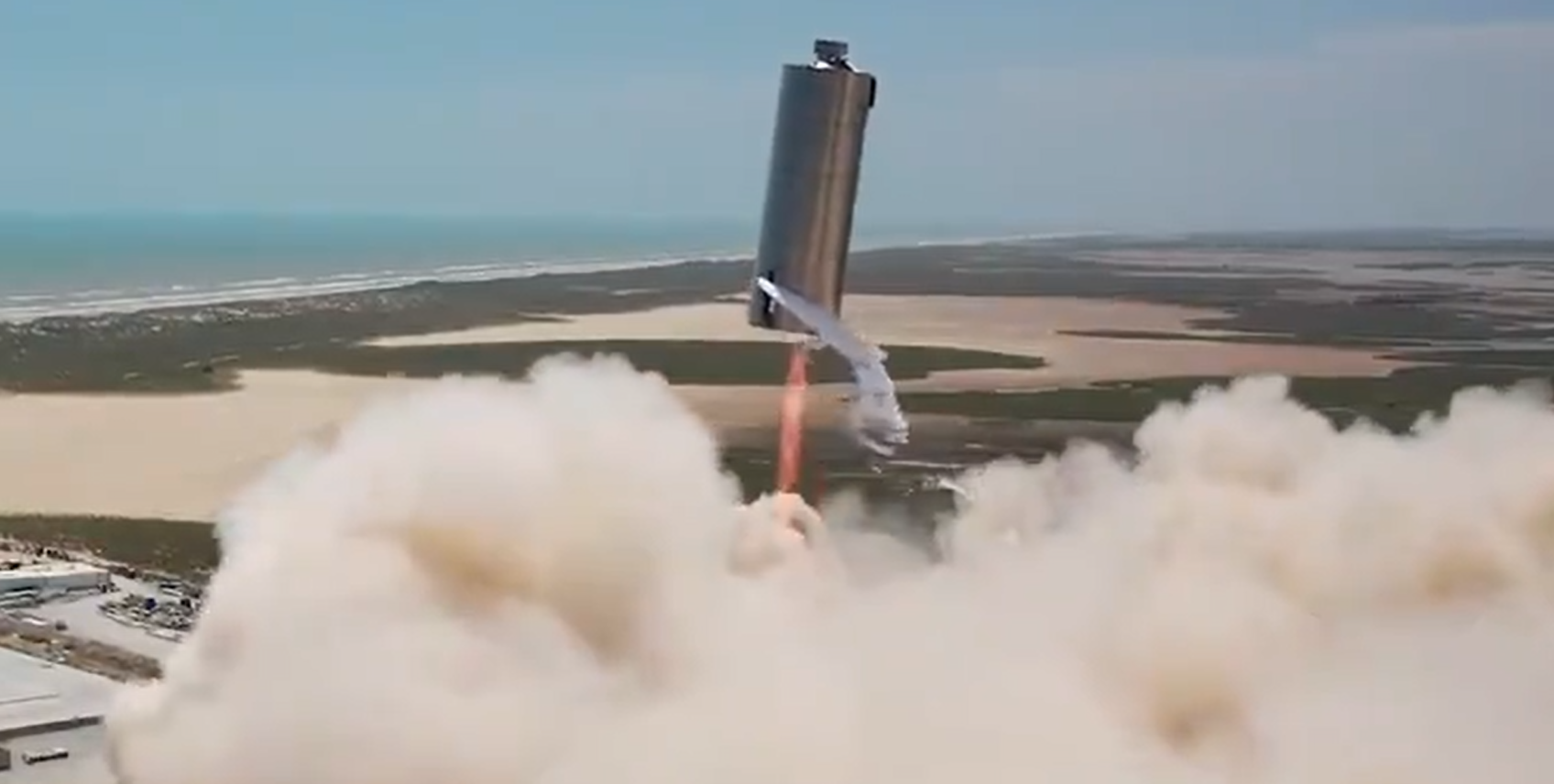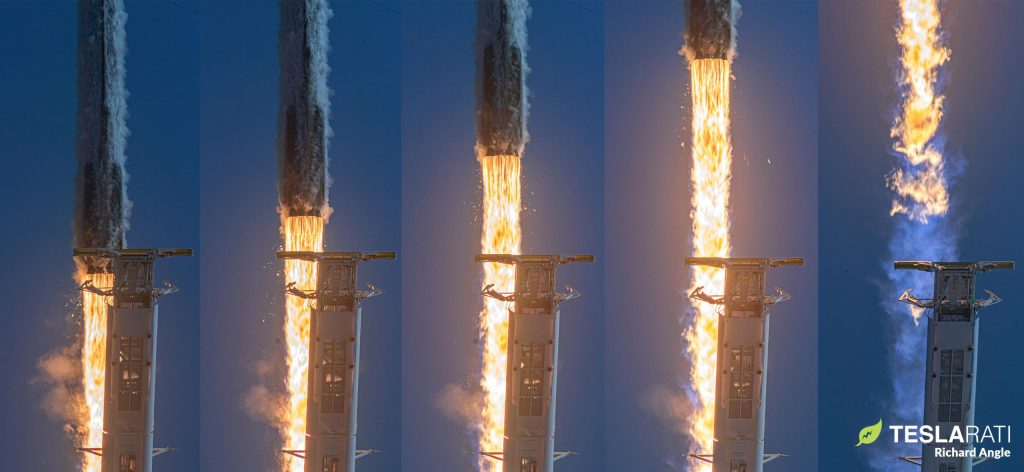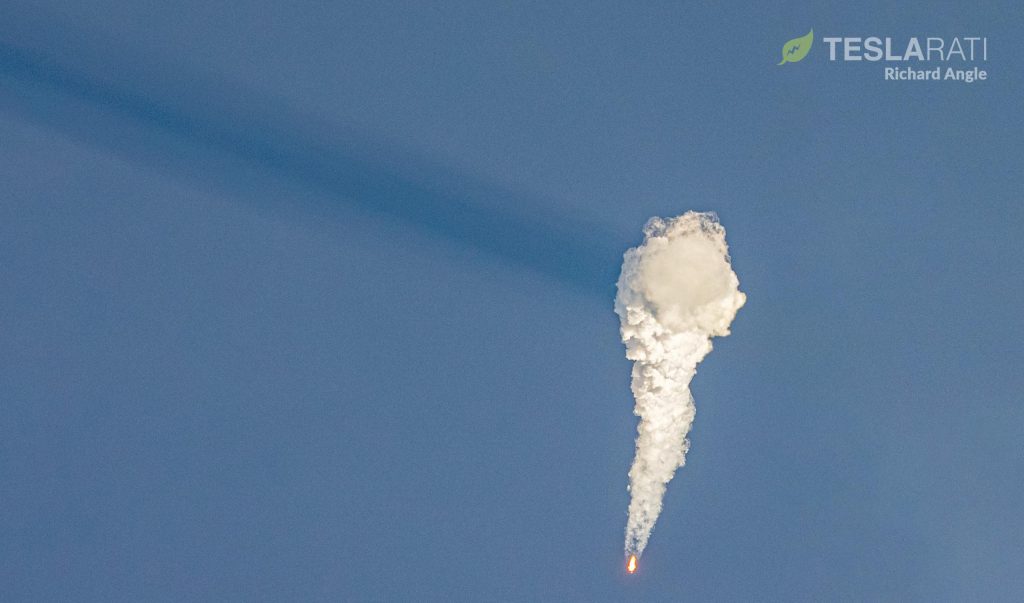

News
SpaceX soars with flawless Starship hop, Starlink launch five hours apart
SpaceX has successfully launched a Falcon 9 rocket with 60 Starlink satellites and hopped a Starship prototype just five hours apart.
Right on schedule, Falcon 9 booster B1060 brought several days of delays to a welcome end, lifting off from Kennedy Space Center Launch Complex 39A (Pad 39A) at 8:48 am EDT (UTC-4). Nine minutes later, B1060 landed aboard drone ship Of Course I Still Love You and the mission’s expendable Falcon 9 upper stage shut off its Merlin Vacuum (MVac) engine after reaching a nominal orbit. Less than 20 minutes after liftoff, all 60 Starlink v1.0 spacecraft were successfully deployed, completing SpaceX’s 11th operational mission and 12th Starlink launch overall.
Less than five hours later, Starship prototype serial number 6 (SN6) ignited its lone Raptor engine and lifted off, soaring ~150m (~500 ft) into the South Texas sky before landing on a concrete pad a few hundred feet away. While largely unrelated from a technical and operational perspective, the back-to-back launch and hop still demonstrate one thing in particular: SpaceX remains as committed as ever to both of its most ambitious projects.
With SpaceX’s 101st launch and 60th orbital-class booster landing, the company’s Starlink satellite internet constellation now has more than 700 operational spacecraft in orbit. According to comments made earlier this year by COO and President Gwynne Shotwell, that should mean that SpaceX will be ready for the first public Starlink beta test just three or four launches from now.
In May 2020, the executive noted that that public beta was expected to begin after 14 launches. Based on interactions with the FCC over the last several months, SpaceX is only counting upgraded v1.0 satellites as part of the operational Starlink constellation, meaning that Shotwell likely meant 14 Starlink v1.0 launches. Over the course of 10 Starlink v1.0 missions, only 5 of the 593 satellites launched have deorbited and burned up in Earth’s atmosphere, while another 8 satellites have lost the ability to maneuver and will likely deorbit within the next several months.


Assuming all 60 Starlink-11 spacecraft are healthy after reaching their final orbits, SpaceX will have ~640 operational satellites in orbit. SpaceX has plans for another two Starlink launches this month, followed by at least one more – the fabled Starlink-14 – no earlier than (NET) October.
Two Starship hops in 30 days
Starship SN6’s successful hop debut is also great news for SpaceX’s ambitious next-generation rocket development program, opening up the launch pad for a new tank pressure test and SN5’s second hop. According to CEO Elon Musk, the company’s near-term goal is to complete “several” hops to refine and routinize Starship launch procedures. Once fairly routine, SpaceX will likely begin preparing for Starship SN8’s hop debut, representing the first flight of a Starship built entirely out of a new steel alloy.
If things go according to plan, Starship SN8 will be the first ship to fly with a nosecone, flaps, header tanks, and three Raptor engines. The ship will also be the first to attempt a truly bizarre skydiver-style landing, in which SN8 will essentially fall through the atmosphere belly-first before flipping upright at the last second for a soft landing. In the meantime, SpaceX’s next Starship test tank (SN7.1) is scheduled to begin testing on September 6th, while SN5 could theoretically be ready for its second hop just a few days after that.
Check out Teslarati’s Marketplace! We offer Tesla accessories, including for the Tesla Cybertruck and Tesla Model 3.
News
Tesla begins Robotaxi certification push in Arizona: report
Tesla seems serious about expanding its Robotaxi service to several states in the coming months.

Tesla has initiated discussions with Arizona transportation regulators to certify its driverless Robotaxi service in the state, as per a recent report from Bloomberg News. The move follows Tesla’s launch of its Robotaxi pilot program in Austin, Texas, as well as CEO Elon Musk’s recent comments about the service’s expansion in the Bay Area.
The Arizona Department of Transportation confirmed to Bloomberg that Tesla has reached out to begin the certification process for autonomous ride-sharing operations in the state. While details remain limited, the outreach suggests that Tesla is serious about expanding its driverless Robotaxi service to several territories in the coming months.
The Arizona development comes as Tesla prepares to expand its service area in Austin this weekend, as per CEO Elon Musk in a post on X. Musk also stated that Tesla is targeting the San Francisco Bay Area as its next major market, with a potential launch “in a month or two,” pending regulatory approvals.
Tesla first launched its autonomous ride-hailing program on June 22 in Austin with a small fleet of Model Y vehicles, accompanied by a Tesla employee in the passenger seat to monitor safety. While still classified as a test, Musk has said the program will expand to about 1,000 vehicles in the coming months. Tesla will later upgrade its Robotaxi fleet with the Cyercab, a two-seater that is designed without a steering wheel.
Sightings of Cybercab castings around the Giga Texas complex suggests that Tesla may be ramping the initial trial production of the self-driving two-seater. Tesla, for its part, has noted in the past that volume production of the Cybercab is expected to start sometime next year.
In California, Tesla has already applied for a transportation charter-party carrier permit from the state’s Public Utilities Commission. The company is reportedly taking a phased approach to operating in California, with the Robotaxi service starting with pre-arranged rides for employees in vehicles with safety drivers.
News
Tesla sets November 6 date for 2025 Annual Shareholder Meeting
The automaker announced the date on Thursday in a Form 8-K.

Tesla has scheduled its 2025 annual shareholder meeting for November 6, addressing investor concerns that the company was nearing a legal deadline to hold the event.
The automaker announced the date on Thursday in a Form 8-K submitted to the United States Securities and Exchange Commission (SEC). The company also listed a new proposal submission deadline of July 31 for items to be included in the proxy statement.
Tesla’s announcement followed calls from a group of 27 shareholders, including the leaders of large public pension funds, which urged Tesla’s board to formally set the meeting date, as noted in a report from The Wall Street Journal.
The group noted that under Texas law, where Tesla is now incorporated, companies must hold annual meetings within 13 months of the last one if requested by shareholders. Tesla’s previous annual shareholder meeting was held on June 13, 2024, which placed the July 13 deadline in focus.
Tesla originally stated in its 2024 annual report that it would file its proxy statement by the end of April. However, an amended filing on April 30 indicated that the Board of Directors had not yet finalized a meeting date, at least at the time.
The April filing also confirmed that Tesla’s board had formed a special committee to evaluate certain matters related to CEO Elon Musk’s compensation plan. Musk’s CEO performance award remains at the center of a lengthy legal dispute in Delaware, Tesla’s former state of incorporation.
Due to the aftermath of Musk’s legal dispute about his compensation plan in Delaware, he has not been paid for his work at Tesla for several years. Musk, for his part, has noted that he is more concerned about his voting stake in Tesla than his actual salary.
At last year’s annual meeting, TSLA shareholders voted to reapprove Elon Musk’s compensation plan and ratified Tesla’s decision to relocate its legal domicile from Delaware to Texas.
Elon Musk
Grok coming to Tesla vehicles next week “at the latest:” Elon Musk
Grok’s rollout to Tesla vehicles is expected to begin next week at the latest.

Elon Musk announced on Thursday that Grok, the large language model developed by his startup xAI, will soon be available in Tesla vehicles. Grok’s rollout to Tesla vehicles is expected to begin next week at the latest, further deepening the ties between the two Elon Musk-led companies.
Tesla–xAI synergy
Musk confirmed the news on X shortly after livestreaming the release of Grok 4, xAI’s latest large language model. “Grok is coming to Tesla vehicles very soon. Next week at the latest,” Musk wrote in a post on social media platform X.
During the livestream, Musk and several members of the xAI team highlighted several upgrades to Grok 4’s voice capabilities and performance metrics, positioning the LLM as competitive with top-tier models from OpenAI and Google.
The in-vehicle integration of Grok marks a new chapter in Tesla’s AI development. While Tesla has long relied on in-house systems for autonomous driving and energy optimization, Grok’s integration would introduce conversational AI directly into its vehicles’ user experience. This integration could potentially improve customer interaction inside Tesla vehicles.
xAI and Tesla’s collaborative footprint
Grok’s upcoming rollout to Tesla vehicles adds to a growing business relationship between Tesla and xAI. Earlier this year, Tesla disclosed that it generated $198.3 million in revenue from commercial, consulting, and support agreements with xAI, as noted in a report from Bloomberg News. A large portion of that amount, however, came from the sale of Megapack energy storage systems to the artificial intelligence startup.
In July 2023, Musk polled X users about whether Tesla should invest $5 billion in xAI. While no formal investment has been made so far, 68% of poll participants voted yes, and Musk has since stated that the idea would be discussed with Tesla’s board.
-

 Elon Musk1 week ago
Elon Musk1 week agoTesla investors will be shocked by Jim Cramer’s latest assessment
-

 Elon Musk3 days ago
Elon Musk3 days agoElon Musk confirms Grok 4 launch on July 9 with livestream event
-

 Elon Musk15 hours ago
Elon Musk15 hours agoxAI launches Grok 4 with new $300/month SuperGrok Heavy subscription
-

 News7 days ago
News7 days agoTesla Model 3 ranks as the safest new car in Europe for 2025, per Euro NCAP tests
-

 Elon Musk2 weeks ago
Elon Musk2 weeks agoA Tesla just delivered itself to a customer autonomously, Elon Musk confirms
-

 Elon Musk1 week ago
Elon Musk1 week agoxAI’s Memphis data center receives air permit despite community criticism
-

 Elon Musk2 weeks ago
Elon Musk2 weeks agoTesla’s Omead Afshar, known as Elon Musk’s right-hand man, leaves company: reports
-

 News2 weeks ago
News2 weeks agoXiaomi CEO congratulates Tesla on first FSD delivery: “We have to continue learning!”

















